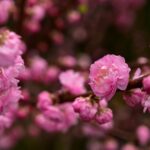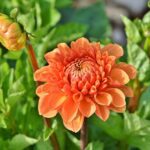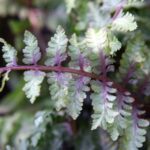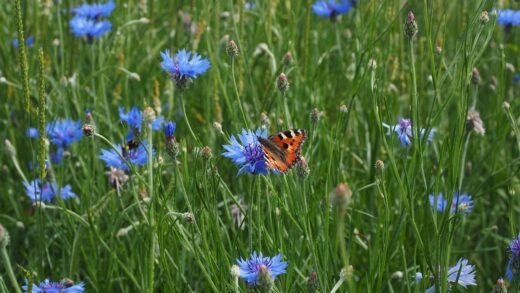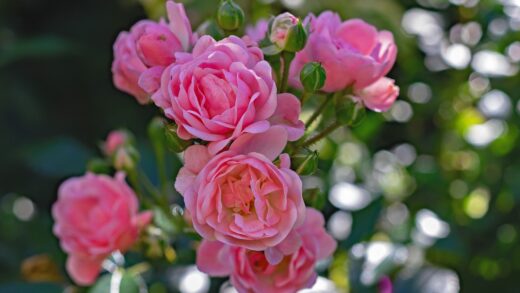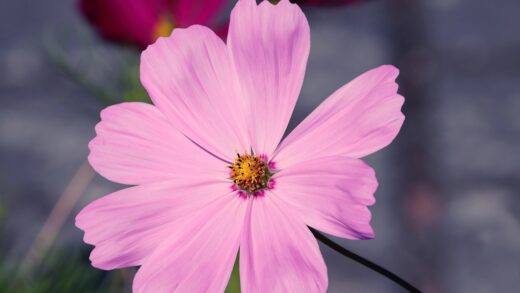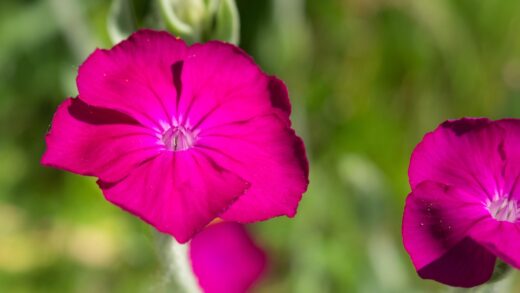One of the most appealing attributes of snow-on-the-mountain is its remarkable resistance to a wide range of common garden pests and diseases. This inherent resilience is due in large part to the milky, latex sap that courses through its stems and leaves. This sap is not only irritating to human skin but is also toxic and distasteful to many browsing animals, such as deer and rabbits, and deters a significant number of insect pests. As a result, gardeners can typically enjoy a full season of beautiful, unblemished foliage without the need for chemical sprays or other intensive pest control measures. While the plant is exceptionally robust, it is not completely immune to problems, with the most significant threats arising from poor environmental conditions rather than from specific pathogens or pests.
The vast majority of issues that can affect snow-on-the-mountain are preventable through proper cultivation practices. The most critical factor is ensuring the plant is sited in a location with excellent drainage and full sun. Poorly drained, waterlogged soil is the primary cause of root rot, arguably the most serious and common ailment to affect this species. Similarly, planting in a location with inadequate air circulation or too much shade can create a humid microclimate that may encourage the development of fungal diseases like powdery mildew, although this is still relatively uncommon.
In terms of insect pests, the plant is rarely troubled. Its toxic sap acts as a powerful deterrent, meaning that common garden scourges like aphids, spider mites, or Japanese beetles generally leave it alone. Occasionally, you might find a small infestation of aphids on the newest, most tender growth, but these are unlikely to cause significant damage to an otherwise healthy plant. The absence of serious pest pressure makes it an excellent choice for organic gardeners or for those who wish to minimize the use of pesticides in their landscape.
Ultimately, the health of your snow-on-the-mountain is directly tied to providing it with the growing conditions it prefers. By focusing on the fundamentals – full sun, well-drained soil, and avoiding overwatering – you can create an environment where the plant’s natural defenses are at their strongest. This proactive, preventative approach is far more effective than any reactive treatment for the rare problems that might arise. A healthy plant grown in the right conditions is its own best defense against pests and diseases.
General disease resistance
Snow-on-the-mountain’s reputation as a disease-free plant is well-earned. Its tough, adaptable nature, combined with the protective qualities of its sap, makes it an inhospitable host for many common plant pathogens. Unlike more delicate ornamentals that may be susceptible to a long list of blights, rusts, and wilts, this Euphorbia species typically remains healthy and vibrant throughout the growing season with very little intervention. This robust constitution is a key reason for its popularity among gardeners seeking reliable, low-maintenance landscape plants.
More articles on this topic
The plant’s preference for dry conditions also contributes to its excellent disease resistance. Many of the most problematic fungal and bacterial diseases thrive and spread in damp, humid environments. Because snow-on-the-mountain performs best in full sun with soil that is allowed to dry out between waterings, it naturally inhabits a space that is less conducive to the proliferation of these pathogens. Practices such as watering at the base of the plant rather than overhead further reduce the risk by keeping the foliage dry.
Good garden hygiene is another simple but effective way to bolster the plant’s natural defenses. This includes clearing away the dead plant debris at the end of the season. While the plant itself is resistant, the decaying organic matter can potentially harbor fungal spores or provide a place for pests to overwinter. By removing the spent plants after the first frost, you ensure that the garden bed is clean and ready for the next season, minimizing the chance of any potential problems carrying over from one year to the next.
While it is exceptionally resistant, it is important to remember that no plant is completely immune to disease, especially if it is under stress. A plant that is weakened by being in the wrong location – for example, a shady, damp spot – will have its defenses compromised. Its inherent resistance can be overcome by overwhelming environmental pressure. This underscores the importance of proper site selection and cultural practices as the foundation of disease prevention. Giving the plant what it needs to thrive is the best way to ensure it remains disease-free.
Fungal issues like root rot and powdery mildew
The most significant disease threat to snow-on-the-mountain is root rot, a fungal disease that is almost always a direct consequence of improper growing conditions. This issue is caused by various soil-borne fungi, such as Pythium or Phytophthora, which thrive in anaerobic, waterlogged soil. When the soil is saturated for extended periods, the plant’s roots are deprived of oxygen and begin to die, making them vulnerable to attack by these pathogens. The fungi then colonize the decaying root tissue, leading to the collapse and death of the entire plant.
More articles on this topic
Symptoms of root rot can be deceptive, as they often mimic the signs of underwatering. The plant may wilt, and its leaves may turn yellow or brown and drop. The crucial difference is that with root rot, the soil at the base of the plant will be wet. If you were to gently pull the plant from the ground, the affected roots would appear dark, mushy, and may even have a foul odor, in stark contrast to the firm, white roots of a healthy plant. Unfortunately, by the time these above-ground symptoms are obvious, the damage to the root system is usually extensive and irreversible.
Prevention is the only effective strategy for dealing with root rot. It begins with selecting a planting site with excellent drainage. If your garden has heavy clay soil, it is essential to amend it with compost or other organic matter to improve its structure. Planting in raised beds is another excellent solution that provides complete control over the soil composition and drainage. Most importantly, you must avoid the temptation to overwater. Allow the soil to dry out between waterings to ensure the roots have access to the oxygen they need.
Powdery mildew is another fungal disease that can occasionally appear, though it is far less common and less destructive than root rot. It manifests as a white, dusty coating on the surface of the leaves, and it is most likely to occur in humid weather and in locations with poor air circulation. While it is unsightly, it rarely causes serious harm to the plant. To prevent powdery mildew, ensure there is adequate spacing between your plants to promote good airflow. If it does appear, you can often manage it by removing the most affected leaves.
Common insect pests
Snow-on-the-mountain is celebrated for its ability to repel most common insect pests, making it a stress-free addition to the garden. The milky latex sap that is characteristic of the Euphorbia family is the plant’s primary defense mechanism. This sap is sticky, bitter, and toxic to many insects, effectively deterring them from feeding on the leaves or stems. Consequently, gardeners rarely need to worry about infestations from pests like beetles, caterpillars, or slugs, which will typically bypass it in search of more palatable plants.
However, a few persistent pests may occasionally test the plant’s defenses, with aphids being the most likely culprits. These small, sap-sucking insects may sometimes be found clustered on the most tender new growth at the tips of the stems. A minor aphid infestation is usually not a cause for concern, as a healthy plant can easily withstand their feeding. Furthermore, these infestations often attract beneficial predatory insects like ladybugs and lacewings, which will help to control the aphid population naturally.
If an aphid population does become large enough to be a concern, they are relatively easy to manage without resorting to chemical pesticides. A strong jet of water from a garden hose is often sufficient to dislodge them from the plant. For more persistent infestations, an application of insecticidal soap can be effective. Be sure to follow the product instructions carefully and apply it in the evening to avoid harming beneficial pollinating insects.
Spider mites are another potential, though infrequent, pest, particularly in hot, dry conditions. These tiny arachnids are difficult to see with the naked eye, but their presence is indicated by a fine webbing on the undersides of leaves and a stippled, faded appearance on the foliage. Like aphids, they can be controlled with a strong spray of water or an application of insecticidal soap. Maintaining adequate hydration for the plant during periods of drought can also help to make it less susceptible to spider mite infestations.
Integrated pest management strategies
An integrated pest management (IPM) approach is perfectly suited for a naturally resilient plant like snow-on-the-mountain. IPM is a holistic strategy that prioritizes preventative measures and natural controls over chemical interventions. The foundation of IPM is creating a healthy, balanced garden ecosystem where plants are strong and pest populations are kept in check by their natural enemies. For this plant, IPM begins with providing the ideal cultural conditions: full sun and well-drained soil. A healthy, stress-free plant is inherently more resistant to any potential pest or disease.
A key component of IPM is regular monitoring. Take time to walk through your garden and observe your plants closely. By regularly inspecting your snow-on-the-mountain, you can catch any potential issues, such as a small aphid colony, before they become a significant problem. Early detection allows for the use of simple, low-impact control methods. This proactive monitoring is far more effective than waiting until a plant is showing severe signs of distress.
IPM also emphasizes the encouragement of beneficial insects. Ladybugs, lacewings, hoverflies, and predatory wasps are all natural enemies of common garden pests like aphids. You can attract these helpful allies to your garden by planting a diversity of flowering plants, particularly those with small flowers like dill, fennel, and alyssum. Providing a source of water and avoiding the use of broad-spectrum chemical pesticides will also help to build a strong population of these beneficial predators, who will act as a free, 24-hour pest control service.
If intervention does become necessary, IPM dictates that you should start with the least toxic methods first. Physical controls, such as hand-picking pests or spraying them off with water, are the first line of defense. If that is not sufficient, you can move on to biological controls or soft pesticides like insecticidal soaps or horticultural oils, which have a lower impact on beneficial insects and the wider environment. Broad-spectrum chemical insecticides should only ever be used as a last resort in a well-managed garden.
Prevention as the best defense
When it comes to maintaining the health of snow-on-the-mountain, the old adage that an ounce of prevention is worth a pound of cure holds particularly true. The entire approach to keeping this plant free from pests and diseases should be centered on proactive, preventative care. This begins before you even plant a seed, with the careful selection of a suitable site. Choosing a location that provides at least six hours of direct sunlight and has soil that drains quickly is the single most important step you can take to prevent future problems, especially root rot.
Cultural practices throughout the growing season also play a crucial preventative role. Spacing your plants appropriately, allowing about 12 to 18 inches between them, ensures that there is good air circulation around the foliage. This helps the leaves to dry quickly after rain and reduces the humidity that can foster fungal diseases like powdery mildew. Similarly, watering the plants at the soil level rather than with an overhead sprinkler keeps the foliage dry and further minimizes the risk of disease.
A fundamental aspect of prevention is to avoid stressing the plant. Stresses can come from many sources: too much water, too little light, or competition from weeds. A stressed plant has a weakened immune system and is far more susceptible to attack from both pests and pathogens. By providing the plant with the conditions it needs to thrive, you are ensuring that its natural defenses are operating at their peak. A happy plant is a healthy plant.
Finally, good end-of-season garden hygiene provides a clean slate for the following year. After the plants are killed by the first frost, remove all the dead plant material from the garden bed. This eliminates any potential overwintering sites for fungal spores or pest eggs. By taking these simple, preventative steps—from site selection to cleanup—you can almost guarantee a season of trouble-free growth from your snow-on-the-mountain, allowing you to enjoy its beauty without the need for reactive treatments.









